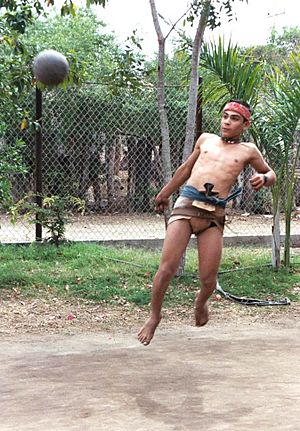Ulama (game) facts for kids

Ulama is an ancient ball game played in Mexico. It is currently becoming popular again in a few communities in the state of Sinaloa. Ulama comes from the Aztec version of the Mesoamerican ballgame. This makes it one of the oldest sports still played today. It is also the oldest known game that uses a rubber ball.
Contents
History of Ulama
The word ulama comes from the Nahuatl word ōllamaliztli. This word combines ōllamas (meaning "playing a game with a ball") and ōllei (meaning "rubber"). Ōllamaliztli was the Aztec name for the Mesoamerican ballgame. This game started at least 2,000 years before BC.
Evidence of this game has been found across nearly all Mesoamerican cultures. This area stretches from modern-day Mexico to El Salvador. It might even include parts of Arizona and New Mexico. Experts have found rubber balls from at least 1600 BC. They also found figures of ballplayers from at least 1200 BC. Around 1,500 ancient ball courts have been discovered.
After the Spanish conquest, the Catholic Spanish tried to stop the game. This was because it had religious and ritual meanings. But the game survived in places like Sinaloa. Spanish influence was not as strong there.
Today, ulama is making a comeback across Mexico. It is even played in Mexico City. There is a cultural center in the Azcapotzalco area where the game is played.
How Ulama is Played
Ulama games are played on a temporary court called a tastei. This name comes from tlachtli, the Nahuatl word for "ballcourt." The court's boundaries are made by drawing thick lines in the dirt. A center line, called an analco, divides the court into two sides. If a ball crosses the end line, called the chichi or chivo, the other team scores a point.
Points are called rayas, which means "lines." This is because tally marks were used to keep score. The scoring system can reset the score to zero. This can make games very long.
The modern game has three main types:
Hip Ulama: Playing with Your Hips
Ulama de cadera means hip ulama. A team usually has five or more players. Sometimes there can be up to twelve players. Players wear loincloths and leather hip pads. These pads offer some protection from the heavy rubber ball. The ball weighs about 3 to 4 kilograms (7 to 9 pounds).
Forearm Ulama: Using Your Arm
Ulama de antebrazo is forearm ulama. This game is played on a smaller field. Teams have one to three players. The ball is lighter than in hip ulama. Players must hit the ball using their wrapped forearm. Women often enjoy playing this version of the game.
Mazo Ulama: The Paddle Game
Ulama de mazo or Ulamad de palo uses a heavy wooden paddle. This paddle weighs 6 to 7 kilograms (13 to 15 pounds). Players use both hands to strike a lighter ball, which weighs about 500 grams (1 pound). Teams usually have three or four players.
Scoring Points in Ulama
The main goal of the game is to keep the ball in play and within the court lines. Depending on the score and local rules, the ball is played either high or low.
A team scores a point when an opponent:
- Hits the ball out of turn.
- Misses the ball completely.
- Knocks the ball out of bounds.
- Touches the ball with any body part other than the hip (in hip ulama).
- Accidentally touches a teammate.
- Lets the ball stop moving before it reaches the center line.
- Fails to announce the score after scoring a point.
The first team to score eight points wins the game. If both teams have the same number of points after a turn, they both start again from zero. One game was even said to have lasted for eight days! Most modern games stop after about two hours.
See also

- In Spanish: Ulama (juego) para niños

